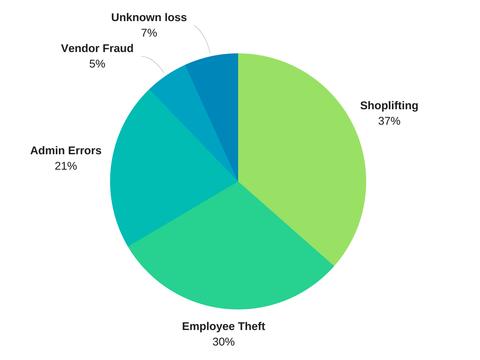 Inventory losses are a big deal in the retail industry. Whether it’s caused by shoplifting, employee theft, or another reason, inventory shrinkage represents a $100 billion annual loss for retailers worldwide. That’s a big problem.
Inventory losses are a big deal in the retail industry. Whether it’s caused by shoplifting, employee theft, or another reason, inventory shrinkage represents a $100 billion annual loss for retailers worldwide. That’s a big problem.
For most retailers, those losses account for just under 1.8% of sales, but for fashion and accessories retailers, the shrinkage rate can reach as high as 2.43%. Throughout the year, that adds up to a lot of potential revenue disappearing into the ether.
That’s why more retailers are to developing and implementing a loss prevention strategy for their l store. It’s also why 80% of retailers are investing budget into in-store security measures to track and deter inventory losses.
FURTHER READING: Learn more about Shopify’s latest partnership with Google and Nest, which helps merchants access a range of high-tech tools to keep their stores secure.
Understanding Shrinkage: The Types of Loss in Retail
Before you can develop and enact a winning loss prevention plan, you need a solid understanding of what causes retail shrink — where it comes from — and the tactics you can deploy to get at the heart of each type of loss.
Let’s take a look at the four main causes of inventory shrinkage:
- Shoplifting,
- Return fraud,
- Employee theft, and
- Administrative error.
Shoplifting
Shoplifting represents the largest single share of retail shrinkage, accounting for 36.5% of annual losses. When you think about shoplifting, you might picture someone walking out the door with a product tucked under their shirt — and that is part of the shoplifting problem.

But it isn’t the whole picture. Shoplifters may steal items ranging in price from $1 to $1,000. They may work alone or in a group of thieves. They may strike once or come back every week.
Shoplifting can take many forms and it can be a problem for any and every retailer. That’s why it’s vital that you take steps to mitigate the potential for shoplifting in your store.
Here are a few ways you can do just that:
- Conspicuous surveillance and signage: Don’t underestimate the power of monitoring your store and making it very clear to customers that you are. Surveillance cameras enable you to catch shoplifters before they ever leave the store, and signage reminding customers about cameras and your willingness to prosecute shoplifters can go a long way in deterring that behavior.
- Deliberate store organization: Depending on your store’s layout, you might be making it even easier for shoplifters to do their thing. Dark or unmonitored corners and overflowing or disorganized merchandise make it easy for shoplifting to go undetected. After all, how can you tell something’s missing when you don’t know where it was to begin with? If your store carries expensive or frequently shoplifted items, consider locking them away in a case.
- Great customer service: Encourage your staff to greet customers when they enter the store, offer help as they look around, and always staff areas like fitting rooms. Reminding shoppers that there are people around to catch shoplifting is another great way to deter shoplifting behavior.
FURTHER READING: Learn more about how signage can help curb shoplifting in your store.
Return Fraud
One of the more overlooked causes of retail loss is return fraud. It’s overlooked because return fraud can be tough to spot in the first place — its effects only evident as they add up throughout the year. Return fraud can also take several different forms, including:
- Returning stolen merchandise,
- Returning merchandise purchased with counterfeit money,
- Returning used merchandise,
- Using counterfeit receipts to return merchandise, and
- Returning exchanged merchandise
Return fraud is harder to curb than shoplifting because of all the ways it can play out, but you can combat each form of return fraud with an intelligent return and exchange policy that’s consistently enforced by employees.
- Require receipts for cash returns: Most retailers do require a receipt in order get a cash refund for returned items, and you should, too. No receipt means customers can only receive store credit or exchange the item. Make sure employees enforce this policy one hundred percent of the time.
- Train employees to spot return fraud: Fraudulent returns aren’t as obvious as a toaster sticking out from under someone’s jacket. That’s why employee training to spot and stop return fraud is a must.
- Require an ID to track returns: Regardless of your return policy and staff training, some fraudulent returns slip through. It’s a good idea to require a valid ID during all return and exchange transactions, so you can flag and address customers with frequent or iffy return behavior.
Employee Theft
Employee theft isn’t something retailers want to have to worry about. It’s easy to say you trust your employees and leave it at that.
Failing to properly prepare for internal theft leaves you vulnerable, though. After all, employee theft makes up a sizable portion of annual retail losses — 30% to be exact. It can take many forms and run the gamut, and not all of it looks like the straightforward theft you might envision. Employee theft includes:
- Straightforward merchandise theft
- Ringing up fake returns and issuing fraudulent gift cards
- “Sweethearting” (neglecting to scan all of a friend or family member’s items or improperly using their employee discount)
- Skimming off the cash drawer — usually done in small amounts at a time that can add up to big losses
So, how can you stop employee theft in your store? You always have the option of placing surveillance cameras throughout employee-only areas, posting signage that employees are being monitored, and checking employees’ bags before they leave. But as you can imagine, that kind of enforcement doesn’t create the best morale or work environment.
Here are a few more practical ways to curb employee theft and fraud:
- Audit your hiring practices: Retailers aren’t always known for stringent hiring requirements, but you should take care in deciding who your frontline partners in the loss prevention fight will be. Look for conscientious employees who conduct themselves with integrity. They’re less likely to take advantage of their power as employees and will be better allies in helping you combat all the other types of retail loss, too.
- Train employees properly: Once you have the right team in place, it’s your job to give them the training they need to mitigate errors contribute to losses, identify shoplifting and fraud, and bring down your retail shrinkage rate.
- Consider your store culture: When your retail store has a great workplace culture, employees stick around longer and are more invested in your store’s success. Work to create a positive, low-turnover culture (in addition to the tips above) and you’ll see incidents of employee theft and fraud drop-off.
Administrative Errors
When your bottom line takes a hit, it never feels good. But not all retail losses stem from malicious or illegal behavior. Simple administrative and paperwork errors actually account for as much as 21.3% of annual shrinkage — sometimes called “paper shrink.”
That’s a big chunk of sales you can hold onto just by implementing the right systems to seamlessly and accurately track inventory and sales.
How does an administrative error translate to retail losses? Mistakes like mislabeling, incorrect markdowns, accounting errors can lead to merchandise being sold for less than it should be or refunded for more than it should be. That means real dollars are lost.
Administrative errors are — by nature — accidental, but that doesn’t mean they can’t be prevented. Let’s talk about how to avoid and catch “paper shrink” before it costs your store:
- Employee training: Whether they’re conducting inventory audits, running around with the price gun, or processing returns, properly trained employees are less likely to make mistakes that end up contributing to your retail losses.
- Point-of-sale (POS) monitoring and inventory management: The only way to stop administrative errors is to catch them and understand how and why they happen. POS systems like Shopify enable you to reduce the opportunity for human error and monitor inventory and transactions as they happen.
Slash Shrinkage to Grow Your Bottom Line
In the retail world, shrinkage is a part of life — but that doesn’t mean you have to settle for throwing away 2% of your sales each year. By developing a solid understanding of why and how retail shrinkage happens, you can devise a pragmatic and effective loss prevention strategy for your store.

